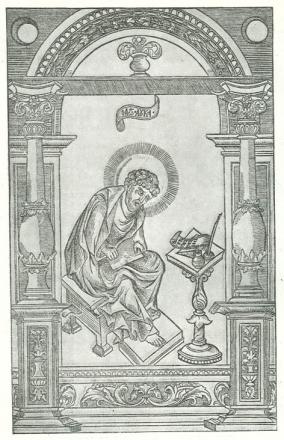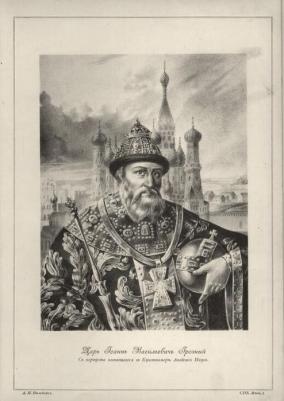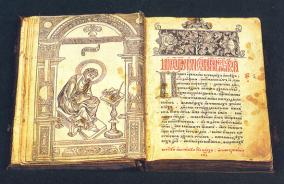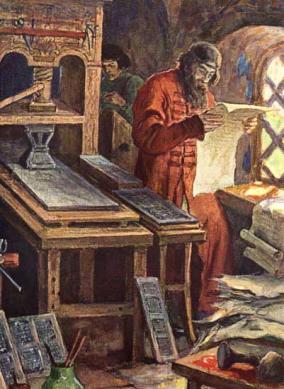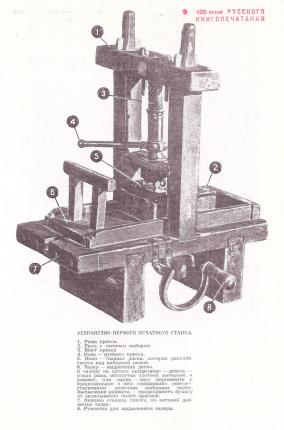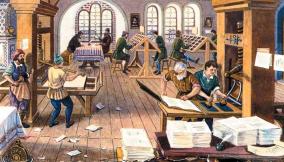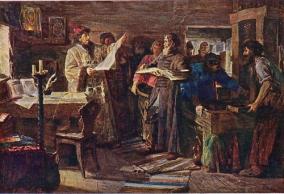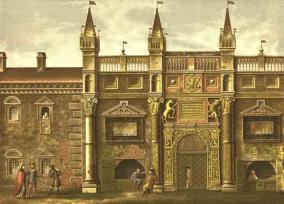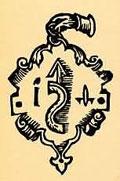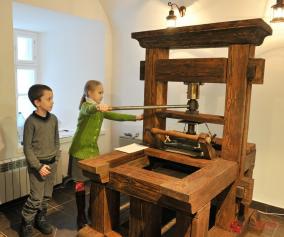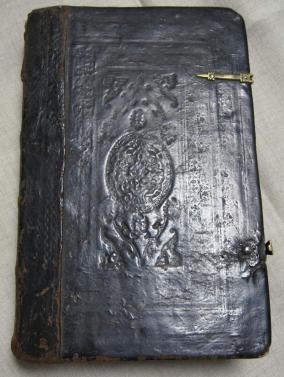"... but swear,that this not was wrote as by a holy spirit or an angel, but by a sinful and perishable hand ..."
From the preface to the "Apostle"
Ivan Fedorov
On March 1 (14), the first Russian exact dated book-"Acts of the holy apostoles, listed by the holy apostle and the Lukons Gospel" was published in 1564 by the decree of Ivan the Terrible and with the blessing of Metropolitan Makary of Moscow. Thanks to this publication, the exact date associated with the history of printing in Russia is known.
Recall that it was over time. Ivan Fedorov worked on the "Apostle" just when the famous St. Basil's Cathedral was erected on the Red Square by the great architects Barma and Postnik. A large building in Moscow was minted by masters from Vladimir, from Pskov, from abroad-and the Annunciation Cathedral of the Kremlin was painted. These are the years when Russia gained strength, acquired the features of a single centralized state, when trade expanded, cities grew, centralized power, the foundations of natural and technical knowledge were laid.
In the Afterword to the first-printed Apostle, there is talk of a great need for books for new churches that were created in Moscow and other cities, most of all in the newly conquered Kazan and in its environs. Tsar Ivan Vasilyevich ordered to build "many churches" and buy for them sacred books "in the marketplace": psalters, gospels and apostles. But, the handwritten books contained a lot of mistakes and inaccuracies. "This came to the ears of the king; Then he began to ponder how to arrange the printing of books, like the Greeks, and in Venice, and in Italy, and with other peoples, so that henceforth the holy books would be published in corrected form. Ivan the Terrible decided to open a state printing house, in which the texts were carefully verified and edited.
One of the most talented Russian people of the 16th century was engaged in organizing the work on the creation of the printing house,it was Ivan Fedorov. The printing work began in the Kremlin and it was transferred to Nikolskaya Street, where a special building for a new printing house was built. For printing, it was necessary to cast the fonts and make the equipment.
The choice of the "Apostle" for the first state printed publication was not accidental, because It was used to teach the clergy. It contains the first samples of the interpretation of the Holy Scriptures by the disciples of Christ. The apostle (from the Greek apostolos - the messenger) is part of the New Testament, the liturgical book of the Orthodox Church, which includes the works of the Apostles written by the Evangelist Luke, the conciliar messages of the apostles James, Peter, John, Judas, the epistles of the apostle Paul and the Apocalypse. It is believed that the Slavonic translation of the Apostle was made by Cyril, Methodius and their disciples.
The text of the Apostle was edited and prepared for publication with the participation of Metropolitan Macarius. Publishers managed to avoid common mistakes during rewriting, and the language of the "Apostle" was cleared of obsolete forms and words, thus approaching the Church Slavonic language of late time.
The Moscow "Apostle" of 1564 is a work in many respects innovative. The Apostle does not yet have a title page, but there is an afterword, which contains all the output of the book and the history of its release. This afterword, most likely, was written by Ivan Fedorov himself and is secular. It can be considered the first printed publicistic work in the history of Russian literature. It should be noted that the epilogue to the Apostle is the only document from which we can learn that Ivan Fyodorov was deacon of the Church of St. Nicholas of Gostunsky in the Moscow Kremlin.
There are 267 sheets in the "Apostle", on each page there are 25 lines. Noteworthy is the engraving on page 14. She portrays the evangelist Luke in a triumphal arch. The engraving was printed from two boards. Presumably, the board for the frame was made by Ivan Fyodorov himself; The engraver who depicted the figure of the evangelist bent over the manuscript is unknown.
In addition to engraving with Luke, there were 48 engravings-screensavers with floral ornament. In the ornamentation of the Apostle, samples of vegetative style of manuscript books of the Trinity-Sergius Monastery were used. In some elements of this ornament, a reflection of the Renaissance is seen.
The very text of the Apostle is dialed into two colors in a smooth, beautiful font. Maintaining the main features of the XVI century manuscript half-century, Fedorov made the font more capacious. The full page of the first-printed "Apostle" included 25 lines. It was also important that the first printer did not want to frighten off readers unnecessary novelty, tried to bring the printed font to handwritten letters, to which Russian people had long been accustomed. When publishing the "Apostle" Fedorov used two inventions, characteristic of Russian printing. First, it is the principle of "crossing lines", when diacritical marks are typed in letters separate from letters. Secondly - the original, invented, apparently, by Fedorov himself, the method of printing in two runs (paint) from one form. First, the letters that should have been printed in red (cinnabar), raised above the surface of the mold and produced an impression. Then they were removed from the set, after which the main text was imprinted on those
tags cloud
- #opening_of_a_branch
- #lecture
- #exhibition
- #virtual_exhibition
- #virtual_tour
- #online_exhibition
- #мультимедийная_выставка
- #poster_exhibition
- #online_event
- #masterclass
- #contest
- #занятие
- #festival
- #video_conference
- #round_table
- #conference
- #seminar
- #дошкольники
- #школьники
- #студенты
- #семья
- #серебряный_возраст
- #инклюзия
- #multimedia
- #Business_meeting_of_virtual_brances
- #The_Multimedia_Centre
- #Drammatika
- #деньмузеевВФРМ
- #ночьмузеевВФРМ
- #RussianMuseum130
- #RussianMuseum125
- #RussianMuseum120
- #RMcatalogues
- #Библионочь
- #книгиГРМ2019
- #игрыРМ
- #фильмыРМ
- #ночьискусствВФРМ
- #Artefact
- #100years_restorationRM
- #Peter_I_350
- #Antarctica200
- #folk_art
- #profession_restorer
- #RM_anniversary
- #SPb_anniversary
- #80летПобеды
